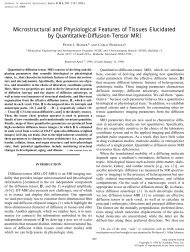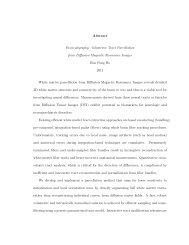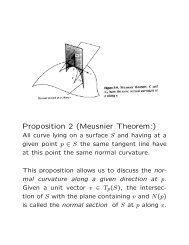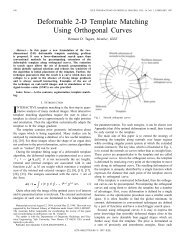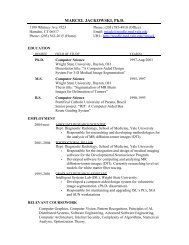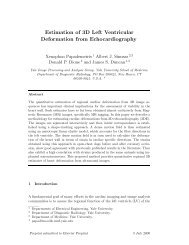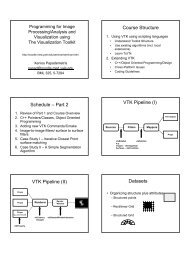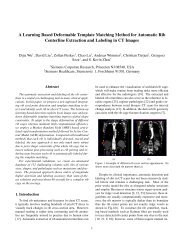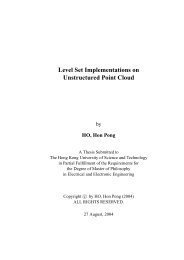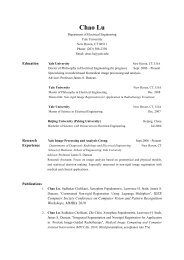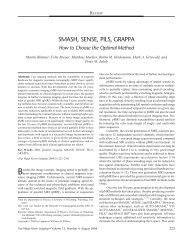Pulsed-field gradient nuclear magnetic resonance as a tool for ...
Pulsed-field gradient nuclear magnetic resonance as a tool for ...
Pulsed-field gradient nuclear magnetic resonance as a tool for ...
Create successful ePaper yourself
Turn your PDF publications into a flip-book with our unique Google optimized e-Paper software.
306<br />
PRICE<br />
‘‘active’’ part of the sequence. By definition,<br />
Ž .<br />
P ,2 must be a normalized function, and so<br />
<br />
H<br />
<br />
Ž . <br />
P ,2 d1. 13<br />
Below, we will consider the further derivation<br />
of Eq. 12 in the context of the GPD approximation<br />
Ž see The GPD Approximation . . However, <strong>for</strong><br />
the present, Eqs. 9 and 12 provide a very clear<br />
conceptual idea <strong>as</strong> to how the PFG method works.<br />
From Eq. 9 , it can be seen that the ph<strong>as</strong>e shift<br />
due to the static <strong>field</strong> cancels. In the absence of<br />
diffusion, the ph<strong>as</strong>e shifts due to the two <strong>gradient</strong><br />
pulses Žor,<br />
conversely, in the presence of diffusion<br />
but with g 0. will also cancel; thus, i 0 <strong>for</strong><br />
all i, and <strong>as</strong> cos 1 in Eq. 12 ,<br />
a maximum<br />
signal will be recorded Žsee<br />
the first series of<br />
ph<strong>as</strong>e diagrams in Fig. 2 . . However, if we have<br />
diffusion, then the displacement function z Ž. i t is<br />
time dependent and the ph<strong>as</strong>e shifts accumulated<br />
by an individual nucleus due to the action of the<br />
<strong>gradient</strong> pulses in the first and second periods<br />
Žduring the <strong>gradient</strong> pulses to be precise see Eq.<br />
9 ; n.b., we neglect the effects of background<br />
<strong>gradient</strong>s. do not cancel. The degree of miscancellation<br />
Ž i.e., larger ph<strong>as</strong>e shift. incre<strong>as</strong>es with<br />
incre<strong>as</strong>ing displacement due to diffusion Ži.e.,<br />
random<br />
motion. along the <strong>gradient</strong> axis. These random<br />
ph<strong>as</strong>e shifts resulting from the diffusion are<br />
averaged over the whole ensemble of nuclei that<br />
contribute to the NMR signal. Hence, the observed<br />
NMR signal is not ph<strong>as</strong>e shifted but attenuated,<br />
and the greater the diffusion is, the larger<br />
is the attenuation of the echo signal Žsee<br />
the<br />
second series of ph<strong>as</strong>e diagrams in Fig. 2 . . Simi-<br />
larly, <strong>as</strong> the <strong>gradient</strong> strength is incre<strong>as</strong>ed in the<br />
presence of diffusion the echo signal attenuates.<br />
In Fig. 3 some experimental 13 C-NMR PFG spec-<br />
tra of 13 CCl are presented to illustrate the loss<br />
4<br />
of echo signal intensity due to diffusion. Net flow,<br />
on the other hand, causes a net ph<strong>as</strong>e shift of the<br />
echo signal Žsee<br />
the third series of ph<strong>as</strong>e diagrams<br />
in Fig. 2 and the end of this subsection.<br />
instead of the diffusion-induced ‘‘blurring’’ of the<br />
ph<strong>as</strong>es which results in a diminution of the echo<br />
signal.<br />
It is important to understand the difference<br />
between <strong>gradient</strong> echoes and spin echoes. In<br />
me<strong>as</strong>uring diffusion, we generally choose to use<br />
the PFG pulse sequence Ži.e.,<br />
a spin-echo sequence.<br />
instead of a <strong>gradient</strong>-echo pulse sequence<br />
Ži.e.,<br />
the PFG pulse sequence without the<br />
pulse and with the second <strong>gradient</strong> pulse having<br />
an opposite polarity to the first pulse . . The<br />
re<strong>as</strong>on is that <strong>as</strong> well <strong>as</strong> refocusing the sign of the<br />
ph<strong>as</strong>e angle accumulated during the first period,<br />
the pulse h<strong>as</strong> the effect of refocusing<br />
chemical shifts and the frequency dispersion due<br />
to the residual B0 inhomogeneity and susceptibility<br />
effects in heterogeneous samples, etc. A gradi-<br />
Figure 3 13 C-PFG NMR spectra of a sample of 13 CCl . The spectra were acquired at 303 K<br />
4<br />
with 100 ms, 4 ms, and g ranging from 0 to 0.45 T m 1 in 0.05-T m 1 increments.<br />
The spectra are presented in ph<strong>as</strong>e-sensitive mode with a line broadening of 5 Hz. As the<br />
intensity of the <strong>gradient</strong> incre<strong>as</strong>es, the echo intensity decre<strong>as</strong>es due to the effects of<br />
diffusion.



